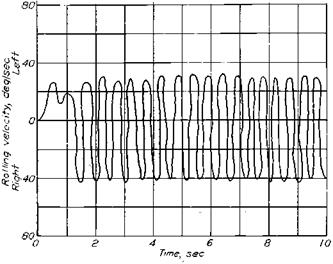Corded Controls
Corded controls, apparently invented in Britain, are thin cylinders, such as actual cord, fastened to control surfaces just ahead of the trailing edge. They are used on one
|
Figure 5.9 Overbalance at small deflections, the downside of control surface bevel. Beveled ailerons with an excessive angle of 32 degrees go through a limit cycle oscillation on an XP-51 airplane. The oscillation is poorly traced from an original. (From Toll, NACA Rept. 868, 1947) |
or both sides of a control surface. Corded controls are the inverse of beveled controls. Bevels on the control surface side that projects into the wind produce relative negative pressures near the bevel that balance the control aerodynamically, reducing operating force. On the other hand, cords on the control surface side that projects into the wind create local positive pressures on the surface just ahead of the cord. This increases control operating force.
Cords on both sides of a control surface are used to eliminate aerodynamic overbalance. On one side they act as a fixed trim tab. Very light control forces have been achieved by cut and try by starting with aerodynamically overbalanced surfaces, caused by deliberately oversized overhang balances. Quite long cords correct the overbalance, providing stable control forces. In the cut and try process the cords are trimmed back in increments until the forces have been lightened to the pilot’s or designer’s satisfaction. Adjustable projections normal to the trailing edge, called Gurney flaps, act as one-sided cord trim tabs.












